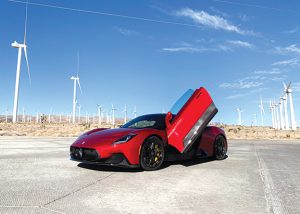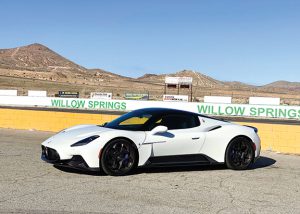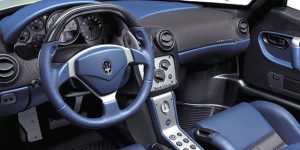Bloomberg
Excessively loud, exceedingly rare, and bursting at the seams with Italian luster, the Maserati MC12 is considered by collectors to be the most desirable car ever produced by the 107-year-old brand. Values surge easily past $2 million for the 50 street versions and 12 racing versions produced for only four months between 2004 and 2005.
The modern version of the MC12 is nothing like that, which is OK by me. The old MC12 is so deafening and ponderous behind the steering wheel that every hour inside it ages you by years. It bakes you inside like a Thermidor and wears you down like a rotary stone.
A shorter, lighter, quicker, nimbler, and more attainable proposition all-around is the MC20. It is Maserati’s first supercar in more than a decade and contains the first engine made in-house in more than 20 years. It lacks the visual and auditory drama of its predecessor, but on the upside will be far more available—to anyone who wants to pay the $212,000 MSRP, before extras.
It also proves a diverting drive, as I discovered recently at the historic Willow Springs International Raceway on a winter-bright afternoon in the California desert.
Named after its purpose and birth date—MC for Maserati Corse (“Maserati racing,†roughly translated) and 20 for 2020, the year of its debut—the MC20 looks like what you’d imagine if a Ferrari, a McLaren, and a Lotus had a baby. It doesn’t come off original per se, but it does look pretty.
The cockpit sits well-positioned between a gently curved hood with deep air ducts set in each nostril and more outflows tucked into the rear three-quarter hips of the car. Defining the backside are rounded edges over the standard 20-inch wheels and a Plexiglass-looking windshield, notched with a
rib-like pattern similar to that of the Ferrari F8.
The butterfly doors of MC20 are the most arresting part of the exterior—which open up and out to improve the ergonomics of getting in and out. I am grateful that the door handles are not the weird lever things Lamborghini has taken to using nor the snapping-turtle ones found on the Porsche 911 Turbos, although once inside, the button to activate the doors and get back out sits at an awkward spot and proves difficult to engage.
The engine note of MC20 at 50mph sounded is far quieter than the Porsche 911 GT2 and the camera-style rear-view mirror projected a video of the road behind rather than the road itself, was incredibly annoying. Maserati implemented this camera rather than a good old-fashioned mirror reflecting the immediate view presumably because visibility is terrible: you basically can’t see a darn thing behind you thanks to that Plexi cover over the rear hatch.
A chap at the track showed that the camera can be switched off by flipping a little lever on the mirror, which helped with the annoyance, even if it did absolutely nothing to improve visibility.
The MC20 has two 10-inch screens, one in the cockpit and a touch-screen in the carbon-fiber-couched dashboard. Simplicity is the key in this club, with a wireless smartphone charger, a driving mode selector, speed selector buttons, window controls, and a tiny storage compartment underneath the armrest comprising the controls. The steering wheel holds a few more buttons: push-start ignition on the left and launch control on the right.
While the MC20’s interior accoutrements and technologies lack the quality and ease (and storage, despite one cupholder) of similarly rear-wheel-drive propositions from Porsche and Ferrari, they exceed the quality and execution of those from McLaren and Lotus, which have suffered through poor craftsmanship, outdated systems, and threadbare comfort.
Extras like auto-dimming mirrors, heated seats, Alcantara accents, premium sound, and a cosmetic carbon fiber package that cost $35,000 pushed the price of the car. Still, the MC20 in this area is livable if limited in comfort compared to competitors such as the Ferrari Roma.
To wit, the mini-trunk won’t hold even a single regulation-sized golf bag, although it may be enough to house a weekend duffel for someone who is not Mariah Carey.
Driving a lone highway through desert scrub and wind turbines conspired to make this MC20 feel cool, like a space ship gliding through some new frontier. But whipping it around the racetrack is where it finally endeared itself to me.
In contrast to the last monster I had on the track—a Lamborghini something or other (all those Huracán variants blend at some point) that required the focus of a jet pilot on Adderall to commandeer it without killing myself—the MC20 instilled a sense of simple joy, sans dread.
With a V6 engine that may deter some who prefer a V8 or V12, the MC20 seems a humbler offering on paper but makes up for it with its pluck. It weighs just 3,306 pounds and claims 621 horsepower, therefore offering a competitive power-to-weight ratio of 5.3 pounds/hp. I felt it.
While it doesn’t offer the blinding torque and speed of a Ferrari F8 Tributo (4.8 pounds/hp) nor the hammer-down thrust of a Porsche 992 Turbo S (5.7 pounds/hp), the uncomplicated, no-drama MC20 occupies a happy middle ground of confident stopping, turning, and accelerating under hot-track conditions. Zero to 60mph is 2.9 seconds. Top speed is 202 mph.
It instills confidence without requiring frayed nerves and enough hail-Mary prayers to fill a rosary in return. I was in and out of the car for four hours, half on the track and half driving on the highway. It won’t suit for extended trips nor steep grades (its low ride height makes it a delicate proposition even with the lift mechanism) but seems like the perfect thing to drive to a cars ’n’ coffee meet-up or on a date.
Even at its best, the MC20 likely won’t single-handedly save Maserati, which has felt the pain of supply chain shortages harder than most and not delivered enough exciting new products to outshine its peers. But it’s a strong step in the right direction, especially when you consider how well the Cayman did for Porsche and the F-Type did for Jaguar.
And when you’re shifting from third to fourth rushing up the hill on turn three at Big Willow, finally hitting the perfect racing line as you do it, anything seems possible. At the very least, the Maserati MC20 punches up the House of the Trident with a revitalizing shot of adrenaline till another game changer—this time electric, as Maserati Americas CEO Bill Peffer promises me will happen “in the near futureâ€â€”rolls off the line.
 The Gulf Time Newspaper One of the finest business newspapers in the UAE brought to you by our professional writers and editors.
The Gulf Time Newspaper One of the finest business newspapers in the UAE brought to you by our professional writers and editors.



